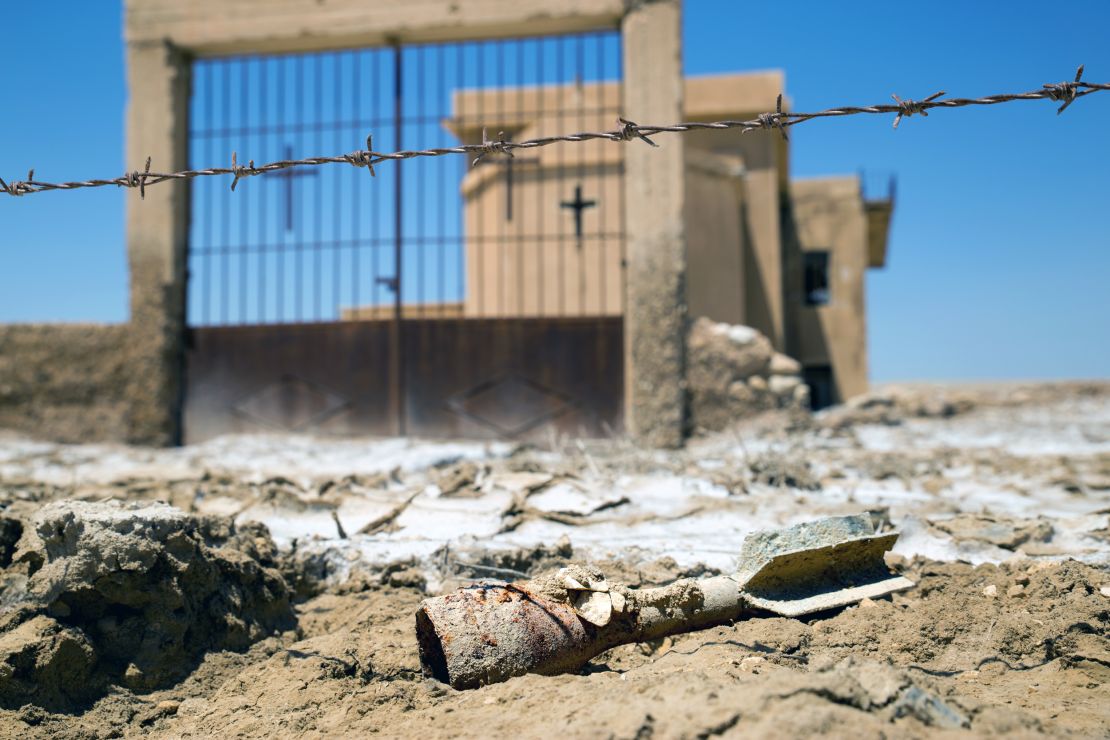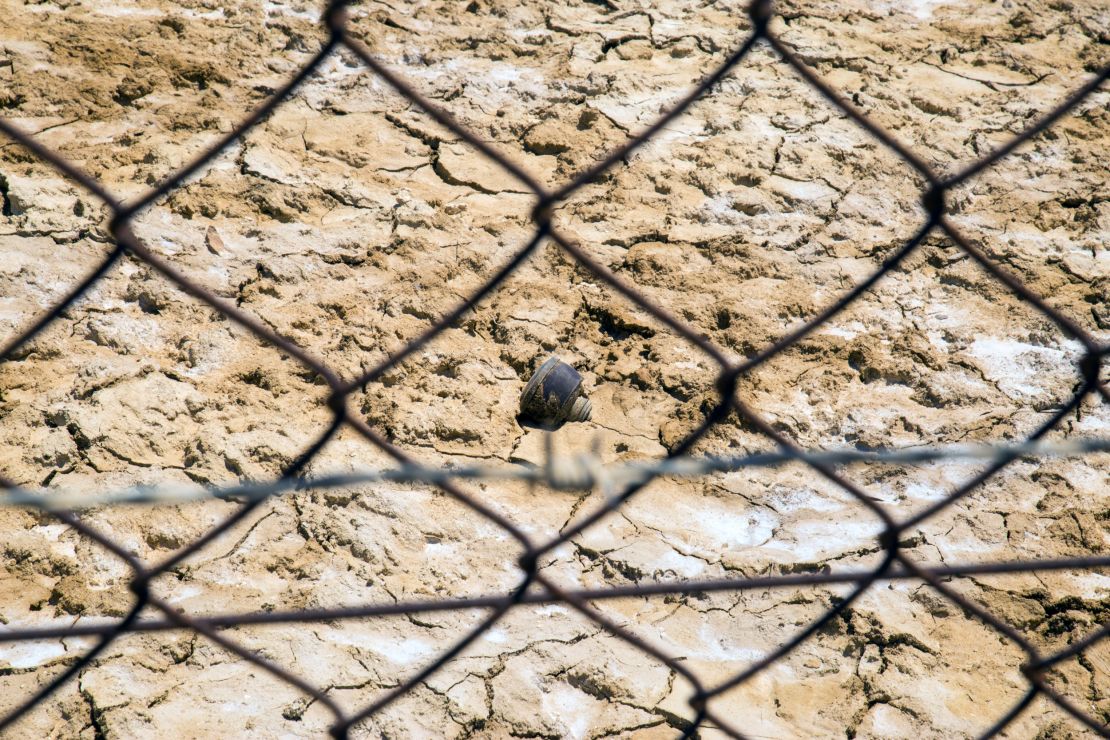Story highlights
Almost 5,000 landmines cover the area near the Jordan River, remnants of the 1967 Six-Day War
The HALO Trust wants to rid the area of mines within 18 months
On a sunburnt stretch of desert near the Jordan River, a weather-beaten Romanian Orthodox church waits for its first visitor in 50 years.
The gated entrance has long since fallen apart, its marble column leaning toward the morning sun. The path to the church – if it ever was a path – is a thick quilt of shrubs and thistles.
Despite being long abandoned, the church retains much of its historic beauty. A colorful mural of a scene from the Bible, half-visible above the entrance to the church, has dulled over time, but is still magnificent. The church door stands open as if ready to welcome the faithful.
Israel’s religious divisions run deep, survey shows
The land on which the church sits is near one of the holiest Christian sites in the world – the place where Christians believe Jesus Christ was baptized in the Jordan River.
There are several other churches at the site, but no one has come near them in decades because they are surrounded by nearly 5,000 landmines.
Barbed-wire fences keep visitors far away, with signs warning “DANGER MINES!” in Arabic, English, and Hebrew. When the Six-Day War ended in an uneasy ceasefire in 1967, the Israeli and Jordanian armies laid mines across the area.
The Jordan River at this point is only a few feet wide – an easy crossing point for an army. The two countries signed a peace agreement in 1994, but the mines were never removed.
Making a holy site safe again
From the safety of the dirt road, a row of anti-tank mines is visible, resting on top of the dry, cracked soil. Nearby, anti-personnel mines sit above the ground, scattered across an empty field. Unexploded ordnance could still be anywhere, and the churches could be booby-trapped.
Where Jesus was baptized
All that is about to change.
The HALO Trust, the world’s largest humanitarian landmine removal organization, has now received permission from the Israelis, Palestinians, and the seven Christian denominations with churches at the site to begin removal of the mines.
“If we didn’t do it, these mines would be here forever,” says HALO Trust CEO James Cowan. “We can make that difference. We can make that go away.”
HALO is not aware of anyone having been injured or killed by the mines in the area, because it is a restricted military zone.
Amid killings and kidnappings, can Christianity survive in the Middle East?
“Country of prophecies and prophets”
Theophilos III, the Greek Orthodox Patriarch of Jerusalem and all Palestine, remembers visiting the site as a teenager before the war made it inaccessible. He smiles as he speaks of visiting again.
“It is a very special place. It is very much connected to the sacred history that began on Mount Sinai and the Prophet Moses and culminated here with the birth of Jesus Christ in Bethlehem and his crucifixion and resurrection in Jerusalem,” the Patriarch says.

A small section of the minefield was cleared for Pope John Paul II, who visited the site in 2000. A modern tourist center on the cleared land was opened to the public in 2011, and approximately 300,000 tourists visit annually.
UNESCO recognizes the official site of the baptism as the east bank of the river in Jordan, called Al-Maghtas, meaning “the baptism.” The site across the river in the West Bank is called Qasr el-Yahud, which means “Passage of the Jew.” In the Old Testament, it marks the biblical site where the Israelites crossed the Jordan River.
Asked whether it bothers him that it has taken so long to clear the minefield and reopen the churches, Theophilos III demurs.
“This is the country of prophecies and prophets. Time is not that important,” he says. “One thousand years, it can be one day in the eyes of God. Every time we celebrate Epiphany, every time we celebrate Easter, it is as if the event happened yesterday.”
Two Muslim families entrusted with care of holy Christian site for centuries
A path for each church
HALO, based in England, worked with the Israeli National Mine Action Authority, a civilian organization that falls under the Israeli Ministry of Defense, to map the minefields and the potential dangers.
It was a complex task.
“For us, when approaching this type of mission, (we assume) everything is active and still working,” says Michael Heiman, the organization’s project supervisor.

Heiman looked at old military maps of the area, reviewed footage from the Six-Day War, and interviewed Israeli soldiers who fought along the Jordan River to better understand the location of the mines. Clearing the minefield is expected to take 18 months, says HALO program manager Ronen Shimoni.
Smaller anti-personnel mines can be excavated and crushed. Larger anti-tank mines need to be cleared manually. Booby traps and unexploded ordnance must be detected and disarmed.
“We do want each of these churches to have its own walking path down to the river. This is why we’re into not just clearing the mines, but also clearing the area between the minefields and the river,” Heiman says.
HALO has cleared mines in 15 countries and four territories, including the West Bank. Much of its funding comes from the public sector, as governments pay to clear areas for housing, farming, or similar uses.
But because the clearing of mines at the baptism site is for religious and cultural reasons, HALO is relying on private donations to pay for the project. HALO estimates the cost will be approximately $4 million.
HALO chief executive Cowan thinks it’s a price worth paying.
“Mines are not only weapons in the present,” he says. “Because what normally happens is that armies move on, wars end, soldiers go home. But what happens with the mine is that it stays in the ground. It maims, it kills long after the conflict has moved on.”

























